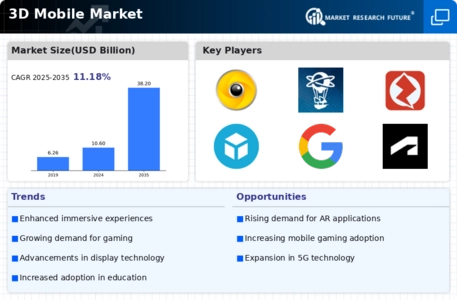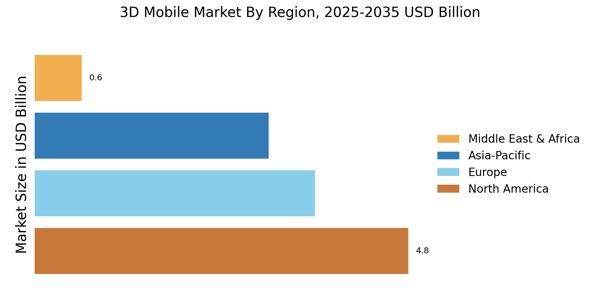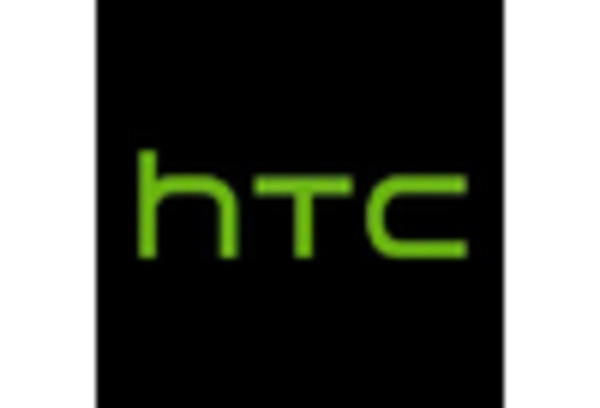Advancements in Mobile Hardware
The evolution of mobile hardware plays a crucial role in the expansion of the 3D Mobile Market. Recent advancements in processing power, graphics capabilities, and display technology have enabled mobile devices to support sophisticated 3D applications. For example, the introduction of high-refresh-rate displays and powerful GPUs has allowed for smoother graphics and more realistic rendering. According to industry reports, the market for mobile GPUs is expected to grow significantly, reflecting the increasing demand for high-performance devices. This hardware evolution not only enhances gaming experiences but also facilitates the development of applications in fields such as virtual reality and augmented reality. As manufacturers continue to innovate, the 3D Mobile Market is poised for substantial growth, driven by enhanced user experiences.
Expansion of 3D Content Creation Tools
The proliferation of 3D content creation tools is a pivotal driver in the 3D Mobile Market. As more individuals and businesses recognize the value of 3D content, the demand for user-friendly creation tools has escalated. Platforms that simplify the design process are emerging, allowing users with varying skill levels to produce high-quality 3D content. This democratization of content creation is reflected in the increasing number of applications available for mobile devices, which cater to both amateur creators and professionals. Market data indicates that the 3D modeling software segment is expected to grow at a compound annual growth rate of approximately 15% over the next few years. This trend suggests that as accessibility improves, the volume of 3D content will likely increase, further fueling the growth of the 3D Mobile Market.
Increased Investment in 3D Technologies
Investment in 3D technologies is a key driver propelling the 3D Mobile Market forward. As businesses recognize the potential of 3D applications to enhance their offerings, funding for innovative projects is on the rise. Venture capitalists and tech companies are increasingly investing in startups focused on 3D content creation, AR, and VR technologies. This influx of capital is fostering innovation and accelerating the development of new applications that utilize 3D technology. Market trends indicate that investment in the 3D technology sector is expected to grow, reflecting the confidence in its future potential. As more resources are allocated to research and development, the 3D Mobile Market is likely to experience rapid advancements, leading to a broader range of applications and improved user experiences.
Increased Demand for Immersive Experiences
The 3D Mobile Market is witnessing a surge in demand for immersive experiences across various sectors, including gaming, education, and entertainment. As consumers increasingly seek engaging content, the industry is adapting to meet these expectations. For instance, the mobile gaming sector has seen a notable increase in revenue, with projections indicating a potential growth rate of over 10% annually. This trend suggests that developers are prioritizing 3D capabilities to enhance user engagement. Furthermore, educational applications utilizing 3D technology are gaining traction, as they offer interactive learning experiences that traditional methods cannot match. Consequently, the growing appetite for immersive content is likely to drive innovation and investment within the 3D Mobile Market.
Rising Popularity of Virtual and Augmented Reality
The rising popularity of virtual and augmented reality technologies is significantly influencing the 3D Mobile Market. As these technologies become more mainstream, mobile applications that leverage 3D capabilities are gaining traction. Industries such as real estate, retail, and tourism are increasingly adopting AR and VR solutions to enhance customer experiences. For instance, virtual property tours and augmented shopping experiences are becoming commonplace, indicating a shift in consumer expectations. Market analysis suggests that the AR and VR market is projected to reach substantial figures in the coming years, with mobile applications playing a critical role in this growth. This trend underscores the importance of 3D technology in creating immersive experiences that resonate with users, thereby driving the expansion of the 3D Mobile Market.


















Leave a Comment